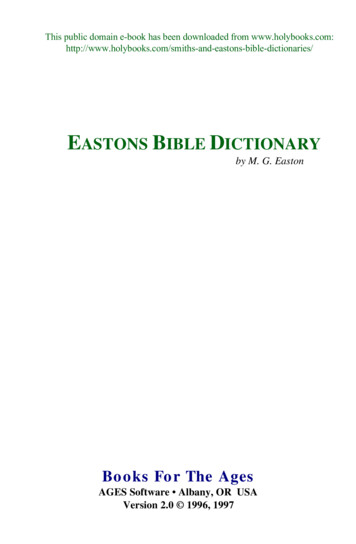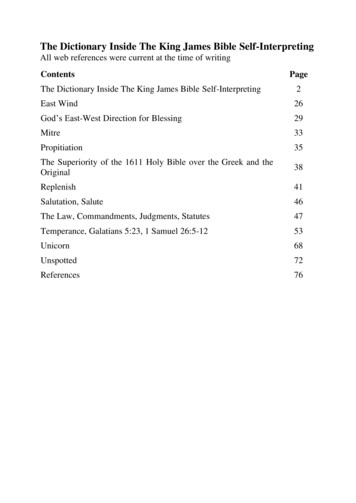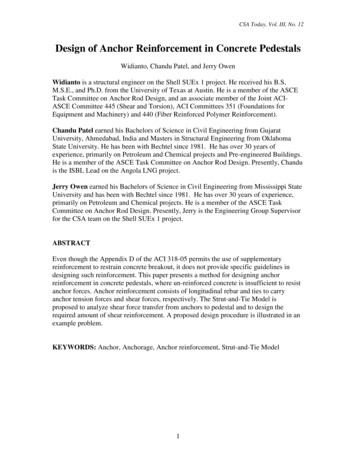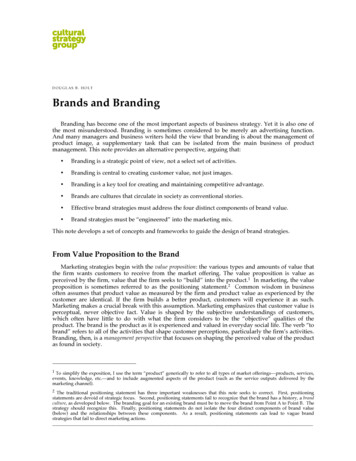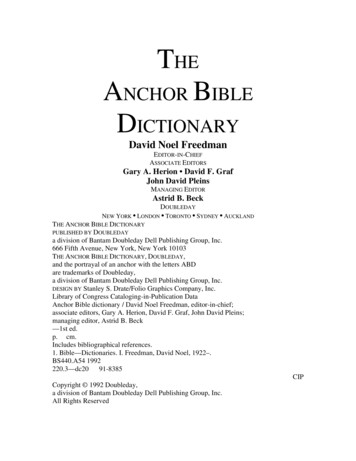
Transcription
THEANCHOR BIBLEDICTIONARYDavid Noel FreedmanEDITOR-IN-CHIEFASSOCIATE EDITORSGary A. Herion David F. GrafJohn David PleinsMANAGING EDITORAstrid B. BeckDOUBLEDAYNEW YORK LONDON TORONTO SYDNEY AUCKLANDTHE ANCHOR BIBLE DICTIONARYPUBLISHED BY DOUBLEDAYa division of Bantam Doubleday Dell Publishing Group, Inc.666 Fifth Avenue, New York, New York 10103THE ANCHOR BIBLE DICTIONARY, DOUBLEDAY,and the portrayal of an anchor with the letters ABDare trademarks of Doubleday,a division of Bantam Doubleday Dell Publishing Group, Inc.DESIGN BY Stanley S. Drate/Folio Graphics Company, Inc.Library of Congress Cataloging-in-Publication DataAnchor Bible dictionary / David Noel Freedman, editor-in-chief;associate editors, Gary A. Herion, David F. Graf, John David Pleins;managing editor, Astrid B. Beck—1st ed.p. cm.Includes bibliographical references.1. Bible—Dictionaries. I. Freedman, David Noel, 1922–.BS440.A54 1992220.3—dc2091-8385CIPCopyright 1992 Doubleday,a division of Bantam Doubleday Dell Publishing Group, Inc.All Rights Reserved
From Volume 2: 619-628ESSENES. A Jewish sect which is known to have flourished from the mid-2d centuryB.C.E.to the time of the First Jewish Revolt against Rome (66–70 C.E.). They aredescribed by a number of Greek and Latin authors, of whom the most important are theJewish writers Philo and Josephus and the Roman Pliny (see HJP 2:555–74). The site ofQumran is widely believed to have been an Essene settlement, and the Dead Sea Scrollsare thought to have once constituted an Essene library. See also QUMRAN; DEAD SEASCROLLS.———A. EtymologyB. The SourcesC. Description of the Sect1. Location and Extent2. Organization3. Religious Practices4. Religious BeliefsD. Correlation with the Qumran Scrolls1. Location2. Admission Procedures3. Communal Property4. Celibacy5. Relation to the Temple6. Religious Beliefs and Ideas7. Further Correlations8. DiscrepanciesE. History of the Sect1. Early Formation2. Interruption of the Qumran Settlement3. Survival after 70 C.E.———A. EtymologyThe name of the sect is variously given as Essaioi (Philo) or Essēnoi (Josephus, Dio,Hippolytus) in Greek, Esseni in Latin (Pliny). Epiphanius mentions both Essēnoi, whichhe identifies as a Samaritan sect, and Ossaioi or Ossēnoi from the vicinity of the DeadSea (Adv. Haer. 19.1–4). The etymology of the name remains an enigma although severalproposals have been put forward. Philo suggested that it was derived from the Gkhosiotēs, “holiness” (Quod Omn 75). Josephus seems to imply a pun on semnotēs,“sanctity” (JW 2.8.2 §119). Most scholars have assumed that the name is of Semiticorigin, like Pharisee and Sadducee. The more popular suggestions include the following.(a) The word Essenes could be derived from the Aram ḥsy (pl. ḥsyn or ḥsyy ), “pious,”the equivalent of the Heb ḥası ̂d. This would suggest a connection between the Essenes
and the ḥası ̂dı ̂m (asidaioi) mentioned in 1 Macc 2:42; 7:12–13 and 2 Macc 14:6, but thisidea is open to the objection that ḥsy is never used in this sense in Jewish Aramaic.(b) The Aramaic syy , “healers” has been proposed especially by Vermes. Philo saysthat they were “therapeutae of God” (Quod Omn 75) and describes another communitycalled Therapeutae (Vita Cont), but he understands the word in the sense of religiousservice rather than healing. It is not apparent that healing was such a dominant interest ofthe Essenes that they would derive their name from it.(c) The Hebrew verb śh, “do” yields a participial form ōśin in rabbinic Hebrew. It hasbeen suggested that this might be an abbreviation for “Doers of the Law” or some suchphrase (Goranson 1984). This form suggests the name Ossēnoi given by Epiphanius, butthe word is too general and is not related to the Essenes by specific evidence.(d) The word ḥsh, “to trust” is likewise only of general relevance. Other suggestions,such as ḥzzy , “seers” or ḥšyy , “silent ones” are likewise inconclusive.It should be noted, however, that the name Essene is only attested in Greek and Latin,and hence the possibility of a Greek derivation deserves serious consideration. Twopossibilities deserve mention.(a) Josephus (Ant 3.7.5 §163–71) uses the word essēn for the high priest’s breastplate(Heb ḥošen) and says that the word signifies logion, “oracle.” He adds that Godforeshadowed victory in battle by means of the shining of the 12 stones, which the highpriest wore upon his breast stitched into the essēn; hence the signification “oracle.” Theessēn ceased to shine about 200 years before the time of Josephus, i.e., in the late 2dcentury B.C.E. We will see below that Josephus attributed to some Essenes the ability toforetell future events. He does not, however, say that they used the essēn, or that theirname was derived from it. A composition dealing with the shining of the ḥošen has nowbeen found at Qumran (Strugnell fc.). It was not necessarily composed there, however,and it does not prove that the community attached any more importance to the ḥošen thandid Josephus. An association of the name Essene with the priestly essēn is an intriguingpossibility, but no more.(b) The term essēnas is attested as a designation for functionaries in the cult of Artemisat Ephesus, who had to observe an ascetic lifestyle while in office (Paus. 8.13.1; Jones1985: 97; Kampen 1986: 61–81). We will see that the accounts of the Essenes in Philoand Josephus were written for hellenized readers and were assimilated to Hellenisticmodels to some degree. Nonetheless, the cult of Artemis at Ephesus seems a ratherremote model for the identification of the Jewish sect.B. The SourcesPhilo provides two descriptions of the Essenes, in Quod Omn 75–91 and Hypothetica11.1–18. There is considerable overlap between these accounts. Philo does not claim tohave firsthand knowledge of the Essenes, and he is evidently dependent on a source orsources. Further, he portrays the Therapeutae in Vita Cont as people who bear somesimilarity to the Essenes but are located in Egypt and lead a less active life.
The most extensive account of the Essenes is preserved by Josephus (JW 2.8.2–13§119–161). A parallel to this account is found in the Philosophoumena, which isattributed to Hippolytus (Haer. 9.18.2–28.2). Many scholars have held that Hippolytus isdependent on Josephus, but Morton Smith has shown decisively that this is not so. Someof the differences between the two accounts are due to confusion on the part ofHippolytus (he identifies the Essenes with the Zealots) or to editorial censure (he deletedapparent references to sun worship). Hippolytus’ account of Essene eschatology,however, may well include authentic information which is omitted by Josephus. Someminor differences between the two accounts can be explained by positing a commonsource which was originally in Hebrew (Smith 1958: 290–91). Josephus confirms most ofthe points mentioned by Philo but goes into greater detail. Another, shorter, account isprovided by Josephus in Ant 18.1.5 §18–22. He also refers to individual Essenes atseveral points (JW 2.20.4 §566–68; 3.2.1 §9–12; Ant 15.10.5 §371–79) and once to the“Essene Gate” in Jerusalem (JW 5.4.2 §142–45).Despite Josephus’ claim that he personally made trial of the three major sects (Life 9–11), he can never have been a member of the Essenes. He claims to have undertaken thethree courses at age 16, then spent three years with Bannus in the wilderness, andreturned to Jerusalem at age 19. He evidently then did not have time to complete even theinitial year of the Essene process of admission. With the possible exception of thetestimony to their endurance in the war against Rome (JW 2.8.10 §151–52), hisknowledge of the Essenes was based on sources. These sources were probably availableto him in hellenized form. Both Josephus and Hippolytus make comparisons withPythagoras and with the Greek conception of the isles of the blest.The most important notice by a pagan author is that of Pliny the Elder, in his NaturalHistory (5.15.73), which was completed in 77 C.E. Pliny had probably been in Palestinewith Vespasian in 68 C.E. He speaks of the Essenes in the present tense, but hisinformation was probably gathered before 70. He mentions them in the context of atopographical survey of Judea and locates them on the W bank of the Dead Sea betweenJericho and En-gedi (En-gedi is said to be “below” them; this should be understood assouthward, in view of the direction in which the description moves). Pliny’s one-sentencedescription of the Essenes confirms some aspects of the accounts in Josephus and Philo,but he exaggerates their rejection of worldly goods when he says that they live “withoutmoney” and also the duration of the sect as through “thousands of centuries.”Except for the enigmatic (probably confused) notice in Epiphanius which we havementioned in connection with the etymology, the other ancient notices (Synes. Dio 3.2;Heges. Hypomnemata, Apos. Con. 6.6.1–8; Jerome, vir. ill. 11 and adversus Jovinianum2.14) add nothing of significance to the 1st-century sources. (All these and some laterwitnesses are conveniently collected by Adam and Burchard; note also the Syriac accountof Dionysios Bar Salibi discussed by Brock.)C. Description of the SectThe classical sources are primarily concerned with the customs of the sect. Josephusalso provides some information about its organization and discipline. We are givenrelatively little account of doctrines and beliefs.1. Location and Extent. Both Philo and Josephus say that the Essenes were spreadthroughout the country. Philo says that they lived in villages and avoided the iniquitouscities; Josephus, on the contrary, says that many lived in each city, but they had none of
their own. The discrepancy here may be due to an idealizing tendency in Philo. Pliny, aswe have noted, located the Essenes by the Dead Sea. Dio, as reported by Synesius,repeats this location but may depend on Pliny. Epiphanius says the Essenes were fromSamaria but puts the Ossaioi in the vicinity of the Dead Sea. In view of Pliny’s notice, weshould assume that there was a major settlement by the Dead Sea; but evidently Esseneswere not confined to one location. Both Philo and Josephus give their number as “morethan four thousand.” This figure was presumably derived from a common source whichmust have been extant in the early 1st century C.E.2. Organization. Josephus introduces the Essenes as one of three Jewish“philosophies.” They are listed among the haireseis (whence heresies) of the Jews byHegesippus and Epiphanius. (Josephus refers to the hairetistai of each philosophy—i.e.,those who choose to follow it.) The modern term sect is influenced by the Christian usageand has the disadvantage of implying a normative orthodoxy, which is anachronistic forJudaism in the era before 70 C.E. Nonetheless, sect is accepted as a more appropriate labelfor the Essenes than for the Pharisees or Sadducees, since it is clear from Josephus thatthey had a distinct organization with clear procedures for admission and expulsion andalso that they were at variance with the Jerusalem temple, which was the focal point ofJudaism at the time. We have as yet no better term than sect to describe this organization.The procedures for admission are described by Josephus JW 2.8.7 §137–42). For thefirst year the postulant was required to follow the way of life but remain outside thecommunity. After this there was a further probationary period of two years before finaladmission. Upon admission “tremendous oaths” were required. These included promisesto “forever hate the unjust and fight the battle of the just,” to be loyal to those inauthority, to conceal nothing from other members, and to guard their secrets, includingtheir books and the names of the angels. There was also provision for expulsion, whichhad dire consequences, because the expelled person was still prevented by oaths frompartaking of common food.The sectarian way of life was characterized by some form of communal property.According to Josephus (JW 2.8.4 §122) “the individual’s possessions join the commonstock and all, like brothers, enjoy a single patrimony.” Philo comments that “they standalmost alone in the whole of mankind in that they have become moneyless and landlessby deliberate action” (Quod Omn 77). Pliny states that they live “without money.” Allthree 1st-century witnesses also attest the celibacy of the sect. Josephus says that theyshun marriage but do not condemn it in principle (JW 2.8.2 §120–21) but also informs usof a second order of Essenes that practiced marriage (2.8.13 §160–61). Philo declarescategorically that “no Essene takes a wife” (Hypothetica 11.14) and is apparentlyunaware of exceptions. Pliny says that they live “without any woman” and renounce sex.He marvels that a community in which no one was born could still perpetuate itselfthrough generations. Philo gives as a reason for celibacy that marriage was perceived as athreat to communal life.Much of the lifestyle of the sect follows from the requirements of communal living.Josephus emphasizes the hospitality extended to sectarians from other communities.Avoidance of wealth and distinction led to rejection of oil (which was also considereddefiling) and to extreme frugality in dress (JW 2.8.4 §123–27). The cohesion of thecommunity was ensured by strict obedience and deference to elders (JW 2.8.9 §146) andby a well-defined hierarchical order (2.8.10 §150). Both Philo and Josephus mention the
rejection of slavery (Quod Omn 79; Ant 18.1.5 §21). Philo suggests that they also avoidedweapons or at least refrained from making them (Quod Omn 78), but Josephus reportsthat they carried weapons on their journeys for self-defense (JW 2.8.4 §125). A figurecalled John the Essene appears as an officer in the war against Rome (JW 3.2.1 §9–12;2.20.4 §566–68).3. Religious Practices. The attitude of the Essenes to animal sacrifice and templeworship has been a matter of much controversy. Philo says that they worshipped God“not
The most extensive account of the Essenes is preserved by Josephus (JW 2.8.2–13 §119–161). A parallel to this account is found in the Philosophoumena, which is attributed to Hippolytus (Haer. 9.18.2–28.2).Many scholars have held that Hippolytus is

